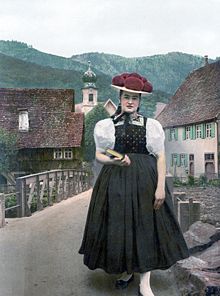Reichenbach (Hornberg)
|
Reichenbach
City of Hornberg
|
||
|---|---|---|
| Coordinates: 48 ° 12 ′ 37 ″ N , 8 ° 16 ′ 50 ″ E | ||
| Incorporation : | April 1, 1974 | |
| Postal code : | 78132 | |
| Area code : | 07833 | |
|
Location of Reichenbach in Baden-Württemberg |
||
Reichenbach is a district of the town of Hornberg in the Black Forest in the Ortenaukreis , Baden-Württemberg . The district of the town of Hornberg is very small in relation to its localities and is essentially limited to the valley floor of the Gutach and the front area of the Reichenbach valley , the village of Reichenbach represents the largest area of the community.
Geography and geology
Reichenbach is a scattered settlement with around 650 inhabitants and consists of the valleys east and west of Hornberg, these include in the east: the actual Reichenbach, Schwanenbach, Schonenbächletal and side valleys. In the west, the Offenbach and Frombach valleys with their side valleys belong to Reichenbach. The highest point of Reichenbach is the Windkapf with a height of 928 m above sea level. NHN .
The mountains here mainly consist of granite , in the area there are numerous Wollsack rocks , of which the Igellochfelsen is the best known. In the eastern area of the district, at Fohrenbühl , there is red sandstone on the granite , which was commercially mined until the 1920s.
history
The place was created by clearing around the year 1080, when Adalbert von Ellersbach received the rule of Hornberg from Heinrich IV . Since then Reichenbach has shared his story with Hornberg. It was not until 1810, when the town was transferred from Württemberg to Baden , that Reichenbach became an independent municipality that was independent of Hornberg. This independence was repealed on April 1, 1974 in the course of the municipal reform.
coat of arms
The former municipal coat of arms shows a green fir tree with a black trunk in silver on a green ground. The municipality has had this coat of arms since 1895.
politics
The district has a mayor and a local council , the system of the false choice of suburbs guaranteed her representation through three seats in the municipality of Hornberg. However, the bogus choice of suburbs was abolished in 2013 despite many concerns on the part of the local council.
The mayor is Gottfried Bühler (2019).
Culture and sights
Reichenbach is one of the three evangelical places where the famous Black Forest Bollenhut is worn.
The typical Black Forest courtyards are characteristic of the townscape , the farmsteads are usually supplemented by a Leibgedingehaus and bakery . The oldest farms can be traced back to 1570 (Hofbauernhof Unterreichenbach).
In the district there are numerous prominent rock formations that show wool sack weathering , such as the Igellochfelsen (in Schwanenbachtal), the Bärenfelsen (in the Schondelgrund), the Buchenstein (on the Kostbachhöhe) and others.
The music and costume association was founded in 1924. The annual highlight of the club's life is a pageant during which the harvest wreath is brought to the town church in Hornberg.
Economy and Infrastructure
Reichenbach was incorporated into Hornberg in 1974 and has an infrastructure characterized by tourism and agriculture and forestry; there are only two sawmills left in commercial operations.
traffic
Until the abandonment of the trade and post route from the Rhine Valley via the Baar to Lake Constance, which had existed since the early Middle Ages, in 1839, Reichenbach was an important, because difficult, stage for long-distance trade. The route climbs here from 364 m in the valley floor to 890 m at the Windkapf; preload services had to be performed on this increase. Another important pass route in the Reichenbach area is the road over the Fohrenbühl .
Numerous well-developed and marked hiking trails criss-cross the area, including the long-distance hiking trails Black Forest-Querweg Rottweil-Lahr and Westweg .
education
The district was looked after from Hornberg in religious matters as well as administrative and educational matters; there was a school in both Unterreichenbach and Schwanenbach.
Individual evidence
- ^ Federal Statistical Office (ed.): Historical municipality directory for the Federal Republic of Germany. Name, border and key number changes in municipalities, counties and administrative districts from May 27, 1970 to December 31, 1982 . W. Kohlhammer, Stuttgart / Mainz 1983, ISBN 3-17-003263-1 , p. 513 .
literature
- City administration Hornberg (ed.): 900 years Hornberg , Konkordia, Bühl [Baden] 1993.


